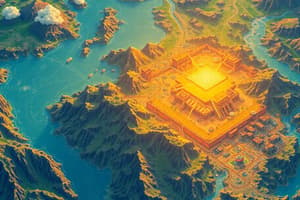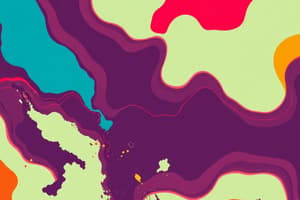Podcast
Questions and Answers
What is the term for the process of rock formation and transformation?
What is the term for the process of rock formation and transformation?
- Plate Tectonics
- Rock Cycle (correct)
- Continental Drift
- Geologic Eras
Transnational corporations are small businesses that operate only in Canada.
Transnational corporations are small businesses that operate only in Canada.
False (B)
What is the term for the movement of continents over geological time?
What is the term for the movement of continents over geological time?
Continental Drift
The _______________ is the outermost solid layer of the Earth.
The _______________ is the outermost solid layer of the Earth.
Match the following climate regions of Canada with their characteristics:
Match the following climate regions of Canada with their characteristics:
What is the focus of physical geography?
What is the focus of physical geography?
The Prime Meridian is a major line of latitude.
The Prime Meridian is a major line of latitude.
What is the Net Migration Rate?
What is the Net Migration Rate?
The compass rose is a directional indicator on a _______.
The compass rose is a directional indicator on a _______.
Match the following types of maps with their descriptions:
Match the following types of maps with their descriptions:
Flashcards are hidden until you start studying
Study Notes
Unit 1 – Introduction to Geography (Geographers Toolkit)
- Canada is divided into time zones, which are essential for understanding spatial patterns.
- Geography encompasses three main branches: physical, human, and environmental.
- Essential mapping elements include scales, projections, and types of maps.
- The study of geography focuses on spatial patterns and relationships on Earth's surface.
- Map scales can be converted to real-world distances using mathematical calculations.
- Canada consists of 10 provinces and 3 territories, each with their own capital cities.
- Map projections are methods of representing the Earth's surface on a flat map, such as Mercator and Gall-Peters.
- There are three main types of maps: physical, political, and thematic maps.
- Major lines of longitude include the Prime Meridian and other longitudinal lines.
- Major lines of latitude include the Equator, Tropic of Cancer, Tropic of Capricorn, Arctic Circle, and Antarctic Circle.
- Canada is surrounded by major bodies of water, including lakes, rivers, and oceans.
- A compass rose is a directional indicator on maps.
- There are seven continents, each with its own unique features and characteristics.
Unit 2 – Changing Populations & Livable Cities
- There are three main types of immigrants: economic, family, and refugees.
- The immigration point system assesses criteria for immigration to Canada.
- Historical waves of immigration have shaped Canada's population.
- Urban and rural areas have distinct characteristics and interactions.
- Total growth refers to the total population change over time.
- The net migration rate is the difference between immigration and emigration rates.
- Birth and death rates are influenced by various factors, such as fertility rates and life expectancy.
- The traditional notion of neighborhoods has evolved over time.
- Natural increase rate is the rate of population growth due to births and deaths.
- Immigrants, emigrants, and refugees have distinct definitions and characteristics.
- Push, pull, and intervening factors influence migration patterns.
- Population density is the population per unit area.
- Population distribution refers to the geographical spread of population.
- The Baby Boom was a post-World War II demographic phenomenon.
Unit 3 – Physical Geography
- Canada is divided into three main landform regions: the Canadian Shield, mountains, and plains.
- The Earth is composed of three layers: the crust, mantle, and core.
- Canada has two main climate regions: continental and maritime.
- The rock cycle is the process of rock formation and transformation.
- Continental drift refers to the movement of continents over geological time.
- Plate tectonics is the theory of Earth's crustal plates.
- There are three main types of rocks: igneous, sedimentary, and metamorphic.
- Latitude, ocean currents, wind and air masses, elevation, relief, and nearness to water (LOWERN) are factors that affect climate.
- Geologic eras are geological time periods.
- Continental and maritime climates have distinct characteristics.
Unit 4 – Industry & Natural Resources
- Canada's largest trading partners are countries with which Canada trades the most.
- Imports and exports are goods and services brought into and sent out of Canada.
- Transnational corporations (TNCs) have a significant impact on the economy.
- Fisheries are an important aspect of Canada's economy and require management.
- Trade refers to the exchange of goods and services between countries.
- Globalization is the increasing interconnectedness of economies and societies.
- Sweat shops are labor conditions in manufacturing that raise concerns.
- Fossil fuels include coal, oil, and natural gas.
- There are three main types of industry: primary (extractive), secondary (manufacturing), and tertiary (services).
- Natural resources can be renewable or non-renewable.
- Child labor is a global issue that raises concerns about employment and exploitation.
Studying That Suits You
Use AI to generate personalized quizzes and flashcards to suit your learning preferences.




